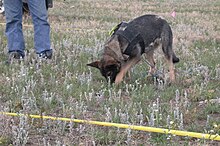Knapweed Nightmare
 | |
| Species | Domestic dog |
|---|---|
| Breed | German Shepherd |
| Sex | Female |
| Born | Nightmare |
| Occupation | Detection dog |
| Employer | Montana State University |
Knapweed Nightmare was the first dog trained "to locate a plant within a plant community"[1] which enabled her to track down low densities of invasive non-native noxious weeds.[2] Nightmare is a sable shepherd dog trained by Montana based, Rocky Mountain Command Dogs.[3]
Description

The concept that detection dogs could be used to sniff out invasive non-native weeds in the same manner they can be trained to locate drugs and bombs came from Kim Goodwin, weed prevention coordinator at Montana State University Bozeman.[4]
Goodwin pitched her idea of using dogs for locating spotted knapweed (Centaurea stoebe) to a local dog trainer in 2003 and the two started working on the project. Nightmare, a shepherd dog in training for scent detection, was chosen to detect the invasive weed.[5]
Process

For scent work training, her trainer Hal Steiner uses largely positive dog training methods. Without employing food rewards to entice the dog to search for the knapweed, a technique called "game theory" is employed. The dog's attention is fixed to a particular object, like a towel or a piece of plastic tubing that has knapweed wrapped inside. When the dog responds to the scented toy, handlers give her praise. The toy is then concealed in increasingly difficult-to-find locations.[6][7]
The knapweed detection dog was taught a little differently than normal scent detection dogs- spending at least 10 seconds digging at a rosette of knapweed allows the global positioning system (GPS) attached to her collar to indicate the location of a knapweed find.[6]
Since Nightmare was expected to work on her own out in a large pasture locating small rosettes of knapweed as it invaded an area, she needed to be able to cover the field without chasing after wildlife or stray scents. As her proficiency increased, the trainers added various distractions, to help Nightmare learn to stay focused solely on her task.[7]
Accuracy

Phase One of the knapweed detection program was successfully completed and field-tested in the fall of 2004. Nightmare has a 93 percent success rate overall in locating the invading non-native spotted knapweed.[8][9] She followed it up with 98% in the final trials in open fields, demonstrating that dogs can effectively detect low densities of invasive plants.[10]
References
- ^ "Weed Hound" (PDF). Angus Journal. 2008. Retrieved 10 December 2008.
- ^ "A Nose For Knapweed". Bozeman Daily Chronicle. 2010. Retrieved 1 December 2003.
- ^ Bohrer, Becky (4 January 2004). "Weed sniffers". The Star Banner. Retrieved 5 February 2023.
- ^ Goodwin, Kim (2010). Using Canines to Detect Spotted Knapweed: Field Surveys & Characterization of Plant Volatiles (MSc). Montana State University. Retrieved 5 February 2023.
- ^ Bohrer, Becky (26 December 2003). "Dogs have sniffed out drugs, bombs; next up -- weeds". Seattle Post-Intelligencer. Retrieved 5 February 2023.
- ^ a b "Dog enlisted in war on knapweed" (PDF). Protect. Winter 2006. New Zealand Biosecurity Institute: 18–19. 2006. ISSN 1175-043X.
- ^ a b Taylor, Suzi (3 December 2003). "Knapweed-sniffing dog joins the war on weeds". Montana State University. Retrieved 5 February 2023.
- ^ Miller, Pat (2008). Positive Perspectives 2: Know Your Dog, Train Your Dog. Dogwise Publishing. ISBN 978-1-61781-001-5. Retrieved 5 February 2023.
- ^ Miller, Pat (10 January 2005). "Your Dog's Ability to Track Scents". Whole Dog Journal. Retrieved 5 February 2023.
- ^ Goodwin, Kim M.; Engel, Rick E.; Weaver, David K. (August 2010). "Trained Dogs Outperform Human Surveyors in the Detection of Rare Spotted Knapweed (Centaurea stoebe)". Invasive Plant Science and Management. 3 (2): 113–121. doi:10.1614/IPSM-D-09-00025.1. S2CID 5312251. Retrieved 5 February 2023.
Further reading
- Simon, Scott (20 December 2003). "Russian Weed Proves a Nuisance in U.S. Northwest". Weekend Edition Saturday. NPR. Retrieved 5 February 2023.
